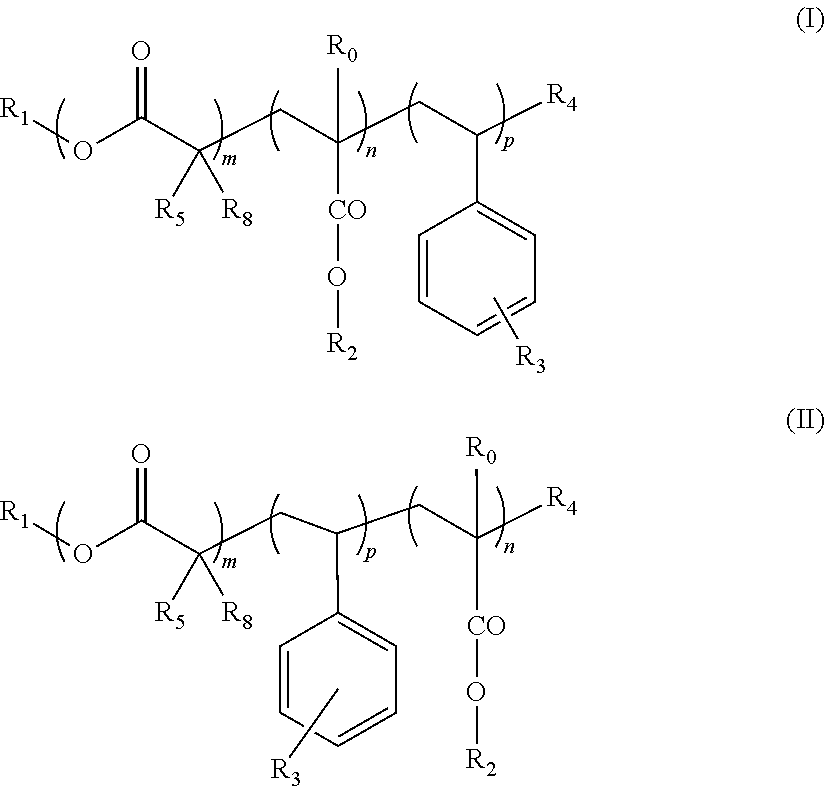Block copolymers and the use thereof for improving the cold properties of fuels or combustibles
a technology of copolymer and block, which is applied in the direction of fuels, transportation and packaging, mixing, etc., can solve the problems of reduced flow properties of fuels or combustibles, difficulty in transporting thereof, storage and/or use, and impaired flow properties of compounds containing n-alkyl, isoalkyl or n-alkenyl substituents, etc., to improve the low-temperature flow properties of fuels or combustibl
- Summary
- Abstract
- Description
- Claims
- Application Information
AI Technical Summary
Benefits of technology
Problems solved by technology
Method used
Image
Examples
example 1
Synthesis of a dodecyl acrylate / 4-acetoxystyrene IAB Block Copolymer
[0187]A solution of initiator I is prepared by dissolving 1 equivalent of octadecyl 2-bromopropionate (1 g, 405 g.mol−1) in 4 ml of anisole. The solution is degassed by nitrogen bubbling before use.[0188]A solution of monomer A / catalyst / ligand is obtained by dissolving 7 equivalents of dodecyl acrylate (4.15 g, 240 g.mol−1), 0.4 equivalent of copper bromide (142 mg, 143 g.mol−1) and 0.4 equivalent of 1,1,4,7,10,10-hexamethyltriethylenetetramine (227 mg, 230 g.mol−1) in 8 ml of anisole, then degassing the solution thus obtained by nitrogen bubbling.[0189]A solution of monomer B / catalyst / ligand is obtained by dissolving 14 equivalents of 4-acetoxystyrene (5.61 g, 162 g.mol−1), 0.4 equivalent of copper bromide (142 mg, 143 g.mol−1) and 0.4 equivalent of 1,1,4,7,10,10-hexamethyltriethylenetetramine (227 mg, 230 g.mol−1) in 4 ml of anisole.
[0190]The initiator solution is added under a nitrogen stream to the solution of m...
example 2
Synthesis of a dodecyl acrylate / 4-acetoxystyrene Statistical Copolymer
[0193]A solution of initiator I is prepared by dissolving 1 equivalent of octadecyl 2-bromopropionate (1 g, 405 g.mol−1) in 4 ml of anisole. The solution is degassed by nitrogen bubbling. 11 equivalents of dodecyl acrylate (6.53 g, 240 g.mol−1) purified beforehand on a basic alumina column, 14 equivalents of 4-acetoxystyrene (5.61 g, 162 g.mol−1) purified beforehand on a basic alumina column, 0.4 equivalent of copper bromide (0.142 mg, 143 g.mol−1) and 0.4 equivalent of 1,1,4,7,10,10-hexamethyltriethylenetetramine (227 mg, 230 g.mol−1) are dissolved in 8 ml of anisole.
[0194]The solution is degassed by nitrogen bubbling.
[0195]The solution of initiator I is added to the solution of monomers under a stream of nitrogen, then the mixture is placed under magnetic stirring at 90° C. and protected from light.
[0196]The progression of the reaction is monitored by 1H NMR spectroscopic analysis (Bruker 400 MHz spectrometer).
[...
example 3
Synthesis of a dodecyl acrylate / 4-acetoxystyrene Statistical Copolymer
[0199]Another statistical copolymer s-I18A127Bac14 was synthesized according to the same protocol as example 2, but using 7 equivalents of dodecyl acrylate instead of 11. (Weight yield of 74%)
[0200]The characteristics of the statistical copolymers obtained are listed in the following table 2:
TABLE 2Mn(3)Yield(4)Ref. (1)mnpR0R1R2R3R4(2)R5R6R7g · mol−1(%)s-I18A1210Bac14(I)11014H—C18H37—C12H25—OCOR6Br—CH3H—CH3670079s-I18A127Bac14(I)1714H—C18H37—C12H25—OCOR6Br—CH3H—CH3750074
[0201]Evaluation of the Performance Under Cold Conditions of the Copolymers in a Fuel Composition
[0202]The copolymers listed in tables 1 and 2 are tested as sedimentation-inhibiting additive in an engine gas oil distillate of B7 type, GOM, the characteristics of which are listed in table 3 below:
TABLE 3GOMGOM (B7)% Total paraffins, measured 20.39by two-dimensional gas chromatography (2DGC) (total weight %)Number of carbons7891011(weight %)0.090.191...
PUM
| Property | Measurement | Unit |
|---|---|---|
| temperature | aaaaa | aaaaa |
| temperatures | aaaaa | aaaaa |
| weight-average molar mass | aaaaa | aaaaa |
Abstract
Description
Claims
Application Information
 Login to View More
Login to View More - R&D
- Intellectual Property
- Life Sciences
- Materials
- Tech Scout
- Unparalleled Data Quality
- Higher Quality Content
- 60% Fewer Hallucinations
Browse by: Latest US Patents, China's latest patents, Technical Efficacy Thesaurus, Application Domain, Technology Topic, Popular Technical Reports.
© 2025 PatSnap. All rights reserved.Legal|Privacy policy|Modern Slavery Act Transparency Statement|Sitemap|About US| Contact US: help@patsnap.com



